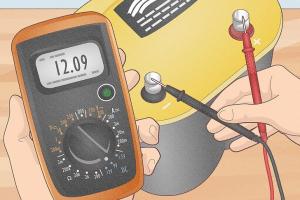Mastering Voltage Testers: A Comprehensive Guide for Homeowners and DIY Enthusiasts

-
Quick Links:
- Introduction
- What is a Voltage Tester?
- Types of Voltage Testers
- How to Use a Voltage Tester
- Safety Tips
- Troubleshooting Common Issues
- Real-World Examples
- Expert Insights
- FAQs
Introduction
Voltage testers are essential tools for anyone working with electrical systems, whether you're a seasoned electrician or a DIY enthusiast. Understanding how to use these devices can enhance your safety, improve your problem-solving skills, and empower you to tackle electrical projects with confidence.
What is a Voltage Tester?
A voltage tester is a device used to determine whether an electrical circuit is live or de-energized. These tools come in various forms, each suited for different applications, from simple non-contact testers to more complex digital multimeters. Knowing the type of voltage tester you need is crucial for effective electrical diagnostics.
Types of Voltage Testers
- Non-Contact Voltage Testers: These allow you to detect voltage from a safe distance without direct contact with wires.
- Contact Voltage Testers: Require direct contact with the circuit to provide accurate voltage readings.
- Multimeters: Versatile tools that measure voltage, current, and resistance, suitable for more detailed electrical diagnostics.
- Solenoid Voltage Testers: Traditional testers that use a small light bulb to indicate the presence of voltage.
How to Use a Voltage Tester
Step-by-Step Guide
Using a voltage tester is straightforward, but following the correct steps is essential for safety and accuracy.
- Gather Your Tools: Ensure you have a voltage tester, safety gloves, and goggles.
- Check Your Tester: Before use, test the voltage tester on a known live circuit to ensure it's functioning properly.
- Identify the Circuit: Locate the circuit you want to test and ensure there are no obstructions.
- Test for Voltage: For non-contact testers, hold the device near the circuit without touching it. For contact testers, touch the probes to the circuit.
- Read the Results: Observe the indicator lights or digital display for voltage readings.
- Power Down: If you need to work on the circuit, turn off the power and re-test to ensure it’s de-energized.
Safety Tips
Electrical safety cannot be overstated. Here are some essential safety tips when using voltage testers:
- Always wear safety gear, including gloves and eye protection.
- Work in dry conditions and avoid using testers in wet areas.
- Never assume a circuit is safe; always test before touching.
- Keep your tools in good condition and replace any damaged equipment.
Troubleshooting Common Issues
Sometimes, voltage testers may not provide accurate readings. Here’s how to troubleshoot:
- No Reading: Check if the tester is functional and if the circuit is powered.
- Inconsistent Readings: Ensure the probes are making good contact with the circuit.
- False Positives: Move the tester closer to the source and ensure other devices are not affecting the reading.
Real-World Examples
Understanding the application of voltage testers in real-world scenarios can enhance learning. Here are a few examples:
Example 1: Home Electrical Outlets
When troubleshooting a dead outlet, a voltage tester can help determine if power is reaching the outlet. If the tester indicates voltage but the outlet is still non-functional, the outlet may need replacement.
Example 2: Light Fixture Installation
Before installing a new light fixture, always use a voltage tester to ensure the circuit is off. This prevents shocks and injuries during installation.
Expert Insights
We consulted with electrical experts on the best practices for using voltage testers. Here are a few insights:
- Always have a backup tool – a second tester can be a lifesaver in case of malfunction.
- Regularly calibrate your testing devices to ensure accuracy over time.
- Invest in high-quality testers, as they often provide better readings and have enhanced safety features.
FAQs
1. How do I know which voltage tester to buy?
Consider your needs—non-contact testers are great for quick checks, while multimeters are better for detailed diagnostics.
2. Are voltage testers safe to use?
Yes, when used correctly and with appropriate safety measures, voltage testers are safe tools.
3. Can I use a voltage tester for AC and DC circuits?
Some voltage testers are designed for both, while others are specific to AC or DC. Check the specifications before use.
4. How often should I test my voltage tester?
It’s good practice to test your voltage tester before each use, especially if it’s been stored for a while.
5. What is the difference between a voltage tester and a multimeter?
A voltage tester is primarily for checking if a circuit is live, while a multimeter measures various electrical parameters, including voltage, current, and resistance.
6. Can I use a voltage tester on live circuits?
Yes, voltage testers are designed to check live circuits, but make sure to follow safety precautions.
7. What should I do if my voltage tester indicates a live circuit but I see no power?
It may indicate a faulty connection or a problem with the circuit. Further investigation is needed.
8. Can I use a voltage tester on a three-phase circuit?
Yes, but ensure your tester is rated for three-phase circuits to avoid damage and ensure safety.
9. What is the best way to store a voltage tester?
Store it in a dry, cool place, and avoid exposing it to moisture or extreme temperatures.
10. How can I improve my skills in using voltage testers?
Practice regularly and consider attending workshops or courses focused on electrical safety and testing.
Random Reads
- Master mcdonalds video game
- How to make infinity symbol iphone
- Mastering dog taming breeding minecraft
- Mastering dll file editing visual studio
- How to make an email address for free
- How to make an fm antenna
- Unlocking saber expert puzzle blox fruits
- How to open tmp files
- How to open torrent file
- How to open terminal in windows